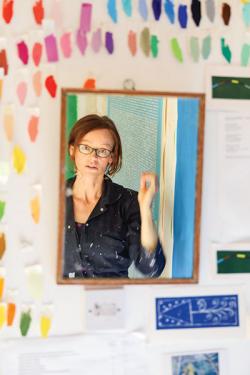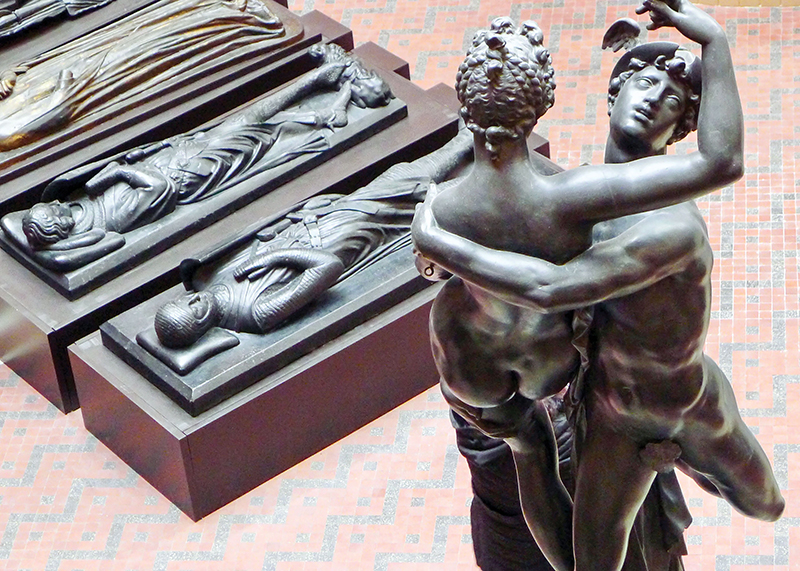Bringing the Invisible to Light: An Artist Explores Our Hidden Universe
Fall
2020
Singularities - Profiles in Physics
Bringing the Invisible to Light: An Artist Explores Our Hidden Universe
Korena Di Roma Howley, Contributing Editor
 Most of what makes up our world is hidden from view, and it’s these facets—the invisible light, the atoms and their building blocks, the relations between things—that inspire artist and teacher Geraldine Cox. With an eye toward nature and the physical universe, Geraldine1 explores how patterns translate visually and echo each other in unexpected ways. The work that results may take form as a painting, a public art installation, a film, or even a class. “I’m interested in how we can express our understanding of the parts of the world that we can’t directly experience,” she says.
Most of what makes up our world is hidden from view, and it’s these facets—the invisible light, the atoms and their building blocks, the relations between things—that inspire artist and teacher Geraldine Cox. With an eye toward nature and the physical universe, Geraldine1 explores how patterns translate visually and echo each other in unexpected ways. The work that results may take form as a painting, a public art installation, a film, or even a class. “I’m interested in how we can express our understanding of the parts of the world that we can’t directly experience,” she says.
Based at Imperial College London, where she was granted a Leverhulme Trust Artist in Residence Award in 2011, Geraldine regularly collaborates with scientists from Oxford, Durham, and other universities to craft workshops aimed at children ages 8 to 11. During the COVID-19 pandemic, the programs have moved online, and when not teaching, she paints, creates, and designs new ways of expressing and exploring knowledge from her home in west London.
Geraldine received her undergraduate degree in physics and later studied fine art with a focus on painting. Following her art degree, she returned to physics via popular science books and lectures and saw an opportunity to approach the subject from a different angle. “I thought, ‘There’s a real opportunity here,’” she says. “It felt like a really optimistic thing to do.”
In her workshop, World of Atoms, Geraldine considers the role of the imagination in learning and creative expression. “A key factor is the imaginative and emotional involvement of the mind and sharing big ideas with children when they are at their most elastic,” she says. The lessons use art projects, poetry, movement, experimentation, and discussion to explore advanced concepts in physics. A dance exercise, for instance, has each student imagine that they’re an electron inside an atom, receiving and emitting light. Other activities include making collages inspired by the cutouts of Henri Matisse and mobiles influenced by Alexander Calder’s hanging sculptures—projects that encourage a multilayered approach to artistic representation.
“I think of the workshops as artworks,” Geraldine says. “I take the same care preparing and reviewing them as I do art.” The children are finding their place in the universe, she says, and lessons often relate to what they know, such as fireworks or the aurora borealis. “I hope that there are aspects they’ll always remember,” she says. “They’re imagining and creating impactful work that expresses what they’ve discovered.”
In 2020, Geraldine was honored by the American Institute of Physics—the parent organization of SPS—with the annual Andrew Gemant Award recognizing individual contributions to the cultural, artistic, or humanistic dimensions of physics. The award’s selection committee praised Geraldine’s articulation of deep physics concepts through visual and performance art and other media, stating that she connects with “a remarkable range of people in innovative ways, and [shares] her passion for the expression of physical truths.”
Reflecting on her unconventional path, Geraldine advises students to take a long perspective on their lives and points to the phenomenon of resonance. “If you follow what you’re genuinely interested in,” she says, “you can make contributions that are uniquely yours, because no one has been on the journey that you’ve been on.”

Notes
1. First name used by request.
For more information about the Andrew Gemant Award, visit aip.org/aip/awards/gemant-award.
Discover More To learn more about Geraldine’s work, visit www.findingpatterns.info. To get more information and see examples of student work from the ongoing World of Atoms workshop, visit worldofatoms.com.
